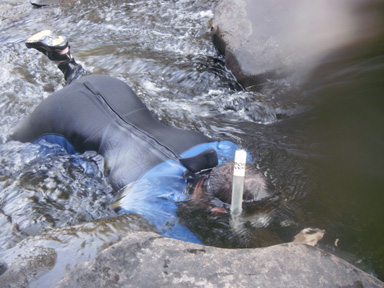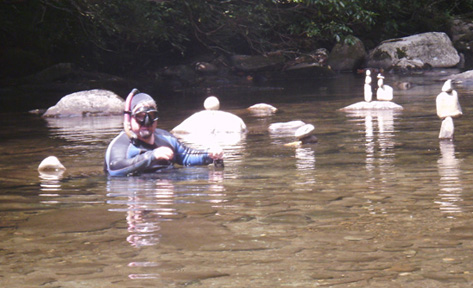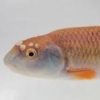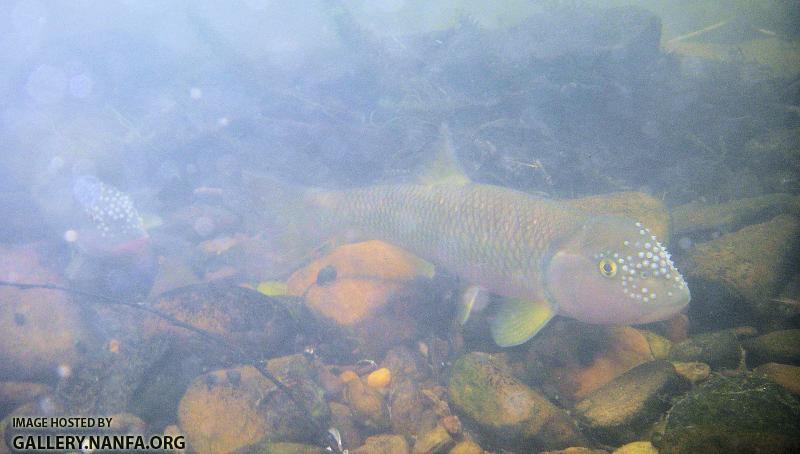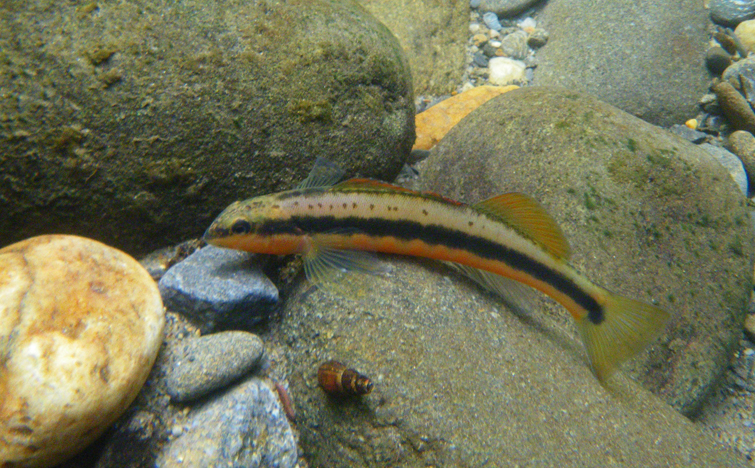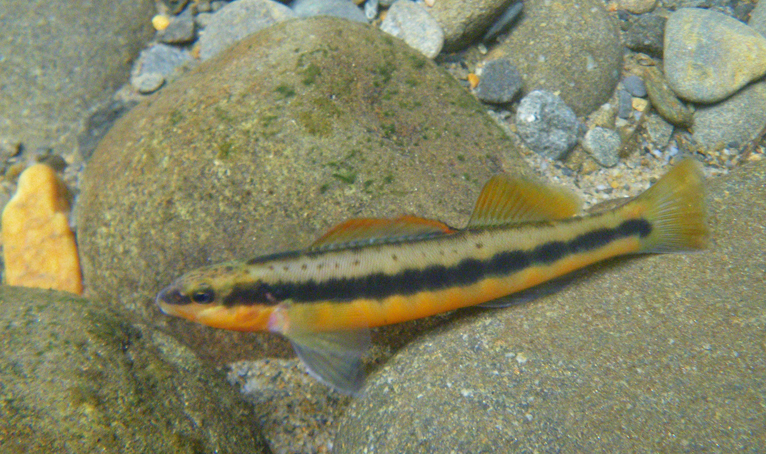Western North Carolina
#68
 Guest_tomterp_*
Guest_tomterp_*
Posted 07 September 2011 - 09:40 PM
Last weekend (Labor Day) I spent at the Cacapon River in WV, near the confluence with the Potomac. For the better part of two days my son and I alternately fished, then snorkeled in all sorts of diverse waters there. I had never seen many darters there before while angling, but we found a really nice cache of what I'm guessing were Greensides (though our first thought was Rainbow) in a shallow and turbulent riffle. The scenery below the surface was spectacular, such life! Good thing I got my snorkeling in while I could, all the rains smothering the east are going to murk things up for a few weeks.
We found the darters pretty easy to capture if we approached from downstream, pulling a seine under us about chin high, and then letting the fish settle a bit before cajoling them onto the net with our bare hands. Amazing to me how the darters would calmly allow us to nudge them around gently without beating a hasty exit.
I'm committed now to going back and attempt to capture the underwater scenes so I can share them with others. I haven't seen too many (any?) underwater video of the Cacapon so I'll be breaking new ground hopefully, albeit amateurishly I'm sure.
Edited by tomterp, 07 September 2011 - 09:41 PM.
#69
 Guest_Creekwalker_*
Guest_Creekwalker_*
Posted 07 September 2011 - 10:06 PM
As a fisherman, you probably see that the distribution of fish is different than what you might have thought. At least it was for me.
Almost nothing happening in the flat water, all the action is in the riffles and rapids.
The one exception I've found is bass. They seem to lurk in the flat water.
Just my amateur opinion tho. (;
Edited by Creekwalker, 07 September 2011 - 10:07 PM.
#70
 Guest_tomterp_*
Guest_tomterp_*
Posted 08 September 2011 - 08:20 AM
That's awesome Tom! I totally agree on the change in perspective. It's a different world under there.
As a fisherman, you probably see that the distribution of fish is different than what you might have thought. At least it was for me.
Almost nothing happening in the flat water, all the action is in the riffles and rapids.
The one exception I've found is bass. They seem to lurk in the flat water.
Just my amateur opinion tho. (;
This being late summer with very low, clear conditions, we needed to find a bit of deeper water to have a shot at a decent bass. We were catching redbreast and smallmouth essentially at will, but no size to the bass, the biggest about 12". One long, slow pool (max depth about 7') I did particularly well on bass (using a dead drifted Yamamoto Senko, my son was terrorizing them on a size 0 Mepps) and after working the hole thoroughly, put on the mask and snorkel to go see what I could find. I saw a lot of small carp, chubs or other sucker type fishes, and sunfish, but nary a smallmouth despite visibility to 15'. I think in the very calm water of the pool the bass were highly wary and retreating under the rock cover that was everywhere before I could spot them
A bit downstream, was a pool with faster current and a series of sharp ridges, where I could approach (snorkeling) from downstream and slowly peek over each ridge down into the upstream hole, and there I found very sizable redbreast along with smallies.
As you observe, the real action for the shiners and darters was primarily in the aerated riffles. Plenty of snails, mussels, clams, and a few fallfish too. My only disappointment was an evident lack of shiner diversity. I'm not going to venture a guess on the species as I didn't keep any for later study and I'm not that experienced - but in the sun they had a brilliant gold/copper horizontal stripe, very striking. Did not see a single satinfin, which I've seen before while angling and one of my favorites.
#73
 Guest_Creekwalker_*
Guest_Creekwalker_*
Posted 12 September 2011 - 07:16 AM
Tangerines seem to be naturally curious and territorial. Rather than fleeing, they often approach to see what the new intruder is up to. Their display usually involves a slow step by step approach towards you or by you in a sort of promenade, often erecting their dorsal fins and revealing views of their brilliant orange bellies.
Very different than the Tuckaseegees which are very shy and pretty difficult to photograph.
Edited by Creekwalker, 12 September 2011 - 07:17 AM.
#79
 Guest_farmertodd_*
Guest_farmertodd_*
Posted 12 September 2011 - 10:50 PM
Todd
#80
 Guest_IsaacSzabo_*
Guest_IsaacSzabo_*
Posted 14 September 2011 - 12:32 AM
Colors seen are a result of prevailing ground water influence. If you were in a warmer stream, you wouldn't see half the coloration you're looking at with these particular fish. In the spring, they're more intense, and the males get this tinsel blue in the pelvic fins and some tinsel blue reflectance down the body.
Todd
Thanks Todd. I wondered if that might be the case, and I've noticed the same phenomenon in cold springs.
Reply to this topic
0 user(s) are reading this topic
0 members, 0 guests, 0 anonymous users


